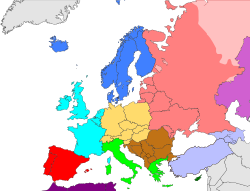Central and Eastern Europe



Central and Eastern Europe, abbreviated CEE, is a generic term for the group of countries in Central Europe, Southeast Europe/the Balkans, Northeast Europe/the Baltics, and Eastern Europe, usually meaning former communist states in Europe. It is in use after the collapse of the Iron Curtain in 1989–90. In scholarly literature the abbreviations CEE or CEEC are often used for this concept.[1][2][3]
Definitions
The term CEE includes all the Eastern bloc countries west of the post-World War II border with the former Soviet Union, the independent states in former Yugoslavia and the three Baltic states – Estonia, Latvia, Lithuania – that chose not to join the CIS with the other 12 former republics of the USSR. The transition countries in Europe are thus classified today into two political-economic entities: CEE and CIS. The CEE countries are further subdivided by their accession status to the European Union (EU): the eight first-wave accession countries that joined the EU on 1 May 2004 (Estonia, Latvia, Lithuania, Czech Republic, Slovakia, Poland, Hungary, and Slovenia), the two second-wave accession countries that joined on 1 January 2007 (Romania and Bulgaria) and the third-wave accession country that joined on 1 July 2013 (Croatia). According to the World Bank, "the transition is over" for the 10 countries that joined the EU in 2004 and 2007.[4] It can be also understood as all countries of the Eastern Bloc.[5]
CEE includes the following former socialist countries, which extend east from the border of Germany and south from the Baltic Sea to the border with Greece:
 Estonia - member of the European Union and NATO
Estonia - member of the European Union and NATO Latvia - member of the European Union and NATO
Latvia - member of the European Union and NATO Lithuania - member of the European Union and NATO
Lithuania - member of the European Union and NATO Germany (Eastern part) - member of the European Union and NATO
Germany (Eastern part) - member of the European Union and NATO Czech Republic - member of the European Union and NATO
Czech Republic - member of the European Union and NATO Slovakia - member of the European Union and NATO
Slovakia - member of the European Union and NATO Hungary - member of the European Union and NATO
Hungary - member of the European Union and NATO Poland - member of the European Union and NATO
Poland - member of the European Union and NATO Romania - member of the European Union and NATO
Romania - member of the European Union and NATO Bulgaria - member of the European Union and NATO
Bulgaria - member of the European Union and NATO Slovenia - member of the European Union and NATO
Slovenia - member of the European Union and NATO Croatia - member of the European Union and NATO
Croatia - member of the European Union and NATO Albania - member of NATO
Albania - member of NATO Bosnia-Herzegovina
Bosnia-Herzegovina Kosovo[6] (independence not recognized by Serbia yet)
Kosovo[6] (independence not recognized by Serbia yet) Macedonia
Macedonia Montenegro - formal invitation to join NATO
Montenegro - formal invitation to join NATO Serbia
Serbia
Other former Eastern Bloc countries in Europe, which are members and associates of the CIS are sometimes included in CEE:[7][8][9][10]
In addition:
 Austria, member of the European Union, was not a communist country during the Cold War, but it is sometimes included in CEE [11]
Austria, member of the European Union, was not a communist country during the Cold War, but it is sometimes included in CEE [11] Georgia (country), was formerly a member of the CIS and is often included in CEE
Georgia (country), was formerly a member of the CIS and is often included in CEE Kazakhstan, although primarily in Central Asia, Kazakhstan is a member of the CIS and has a small proportion of territory in Eastern Europe.
Kazakhstan, although primarily in Central Asia, Kazakhstan is a member of the CIS and has a small proportion of territory in Eastern Europe.
The definition of this region varies, depending on the source.[12][13][14] The term Central and Eastern Europe (with its abbreviation CEE) has displaced the alternative term East-Central Europe in the context of transition countries, mainly because the abbreviation ECE is ambiguous: it commonly stands for Economic Commission for Europe rather than East-Central Europe.[15]
See also
- Baltic states
- Caucasus
- Central Europe
- Central and Eastern European Online Library
- Council of Europe
- East-Central Europe
- Eastern Europe
- Eastern European Group
- Eurasian Union
- Eurovoc#Eastern Europe
- Regions of Europe
- Visegrád Group
References
- ^ Inotai, András (Autumn 2009). "BUDAPEST—Ghost of Second-Class Status Haunts Central and Eastern Europe". Europe's World.
- ^ Z. Lerman, C. Csaki, and G. Feder, Agriculture in Transition: Land Policies and Evolving Farm Structures in Post-Soviet Countries, Lexington Books, Lanham, MD (2004), see, e.g., Table 1.1, p. 4.
- ^ J. Swinnen, ed., Political Economy of Agrarian Reform in Central and Eastern Europe, Ashgate, Aldershot (1997).
- ^ Unleashing Prosperity: Productivity Growth in Eastern Europe and the Former Soviet Union, World Bank, Washington (2008), p. 42
- ^ "Central and Eastern Europe, the Caucasus and Central Asia". OECD.
- ^ Template:Kosovo-note
- ^ http://stats.oecd.org/glossary/detail.asp?ID=303
- ^ http://www.databasece.com/en/data
- ^ http://www.cushmanwakefield.com/en/research-and-insight/2013/changing-world-of-trade/
- ^ http://www.foodnavigator.com/Financial-Industry/Nestle-performance-in-Europe-surprises-analysts
- ^ http://www.rolandberger.at/media/pdf/Roland_Berger_Studie_CEE_in_2020_20101201.pdf
- ^ http://www.weastra.com/cee-countries/
- ^ http://stats.oecd.org/glossary/detail.asp?ID=303
- ^ http://www.rolandberger.at/media/pdf/Roland_Berger_Studie_CEE_in_2020_20101201.pdf
- ^ ECE – United Nations Economic Commission for Europe.
